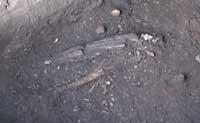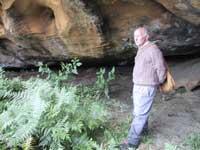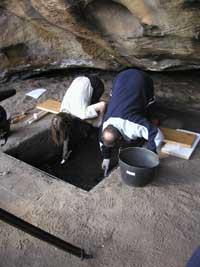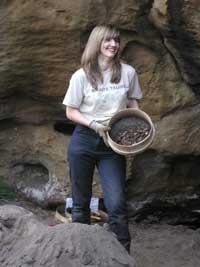A Neolithic Skeleton in Jaizkibel
Some bones have been found on the Gipuzkoan coast… and what? Perhaps, for the non-expert, it is not clear what is the new contribution of the last excavation of Aranzadi.

The truth is that in order to evaluate the importance of the discovery, we must look at the state of archaeology: not many neolithic fossils have been found in Euskal Herria.
The researchers have recognized that luck has been favorable. It is not easy to find these types of tracks, let alone in a survey. The survey is the first approach to a deposit, it is not very excavated, but archaeologists begin to intuit what can be expected of what comes out. In this case, human fossils have been found in the survey. It is surprising.
However, in Neolithic times, the human presence in the area is not surprising. There were two 'natural' steps between Europe and the Iberian peninsula: Catalonia and the Basque Country. From this point of view, the Basque coast was a privileged place both from the orographic and climatological point of view.
Between coquillas

The site is located in a shelter, it is not a cave, but it is an area of natural protection, so it can be an ideal place to live a Neolithic family. It must be taken into account that this time is at the beginning of the Holocene, that is, at the time when the climate began to warm, after the last great cooling of the Pleistocene. And, as the climate is tempering, it can be concluded that the man left the caves and used other shelters.
However, the fact that this deposit of Jaizkibel is full of shells means that this human being exploited the sea. He ate clams, mussels, snails and fish, and shells and bones were piled on the floor of the coat; archaeologists have found fossils from all of them. Therefore, over the years, it became a very special place: the coat with shell floor. The bones have remained buried about 6,000 years, due to the existence of this singular soil.
The bones are fossilized very little, since for it the environment must have certain conditions. In the case of the Jaizkibel deposit, shells were responsible for these necessary conditions. In fact, the area of sandstone acid has become alkaline, so many bones have fossilized and kept whole.
In forced position

In 1983 Juan San Martín discovered the site itself. However, at that time it was not clear what they would find there. To find out, the survey has been conducted by archaeologists from Aranzadi, who have found human bones.
However, they have not found the complete skeleton. Large bones of arms and legs have been found, that is, the two tibias, the two knobs, the two femur, the two cubes, the two rays and the parts of the humers. Small loose bones have also appeared: a tooth, a piece of skull, an astragalo, etc.
Faced with the situation of large bones, the researchers believe that the man was buried in a very forced position, totally inclined, with arms and knees wrapped in the chest and bent to the left. This attitude is not a 'natural' attitude of a body, so archaeologists have proposed to bury the victim tied. On the other hand, from the bones that have lasted, they believe that the body could belong to a man of 30 to 40 years.
They are not the only remains found of human bones and shells. Other bones, supposedly of domestic animals, as well as some useful, have also been explained. In this survey, fragments of ceramics and rocks have also been extracted. It is clear that they made fire, both by the shoots found and by the appearance of small pieces of coal. The deposit has been abundant, so in a single survey, for five months, many materials have been extracted.
When will it be?

Shells are not common in archaeology. However, only some have been found in Europe, especially in the North Atlantic. This can help when making the dating, since the footprints of human beings in a similar way may have similar dating. This, taking into account the consequences of stratigraphy and other factors, researchers have announced that human bones can be between 5,800 and 6,000 years old. However, it is not his last word, it is still missing to date with carbon 14.
As a reference we must remember that dolmens have an approximate dating of 3,500-4,000 years. Experts also classify them in Neolithic times. According to this, it is clear that the remains found in Jaizkibel, around 6,000 years, could correspond to the first Neolithic.
Old times that, supposedly, have not left much information in the fossil record.
Buletina
Bidali zure helbide elektronikoa eta jaso asteroko buletina zure sarrera-ontzian


